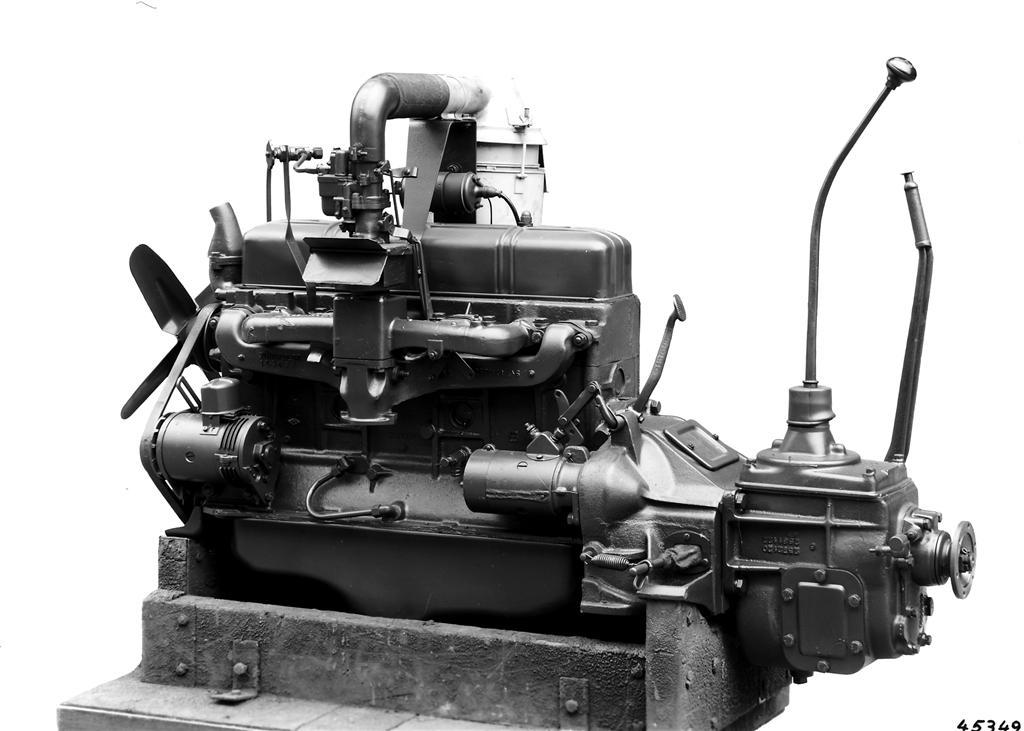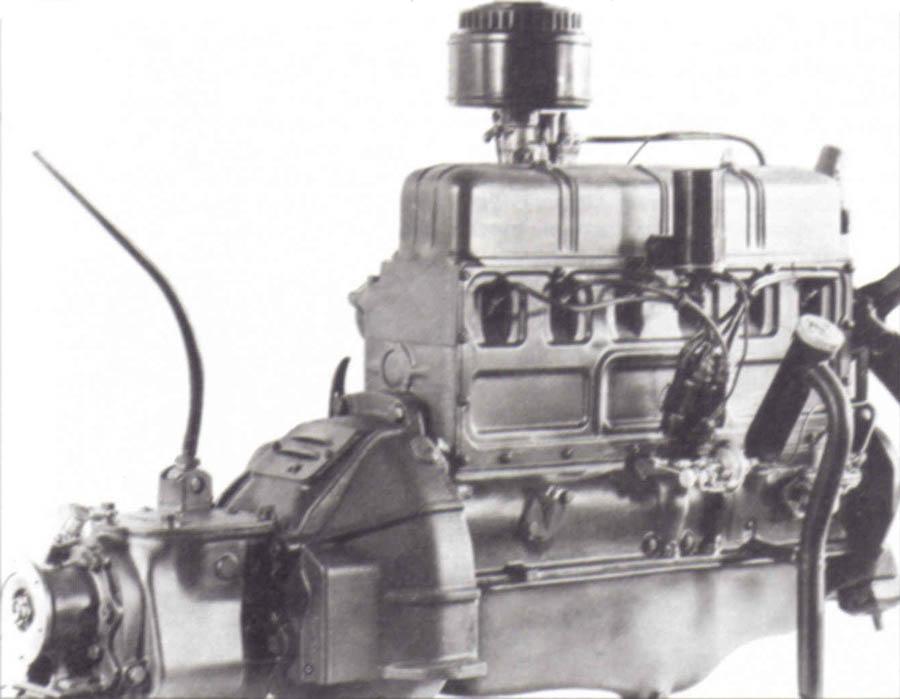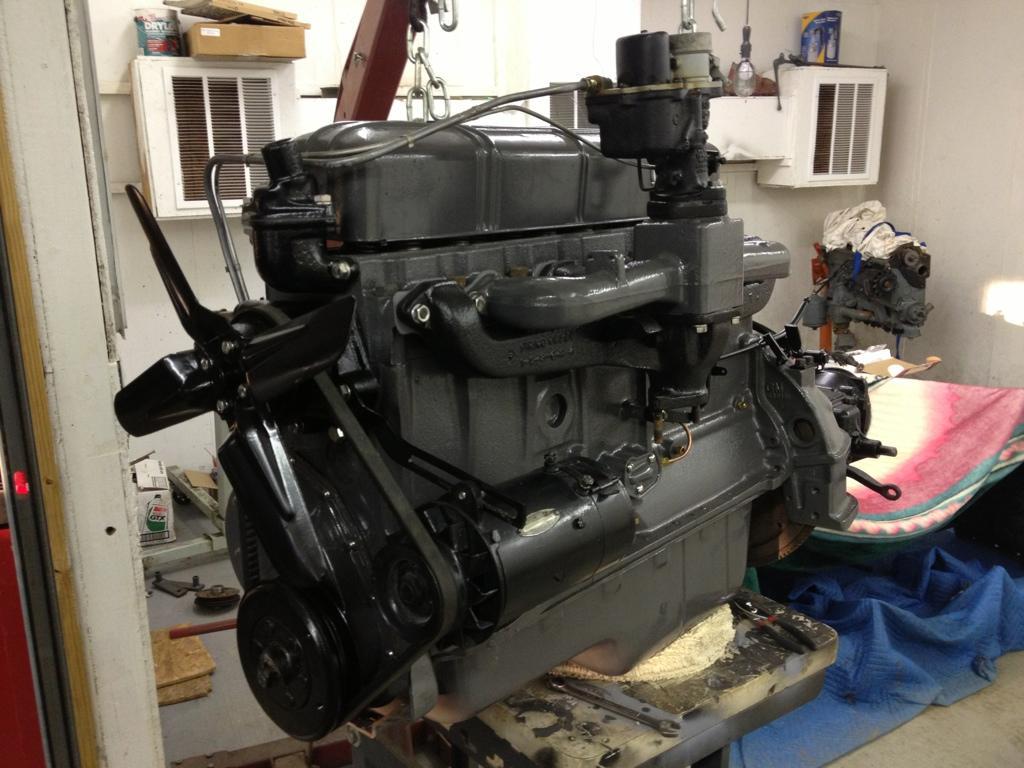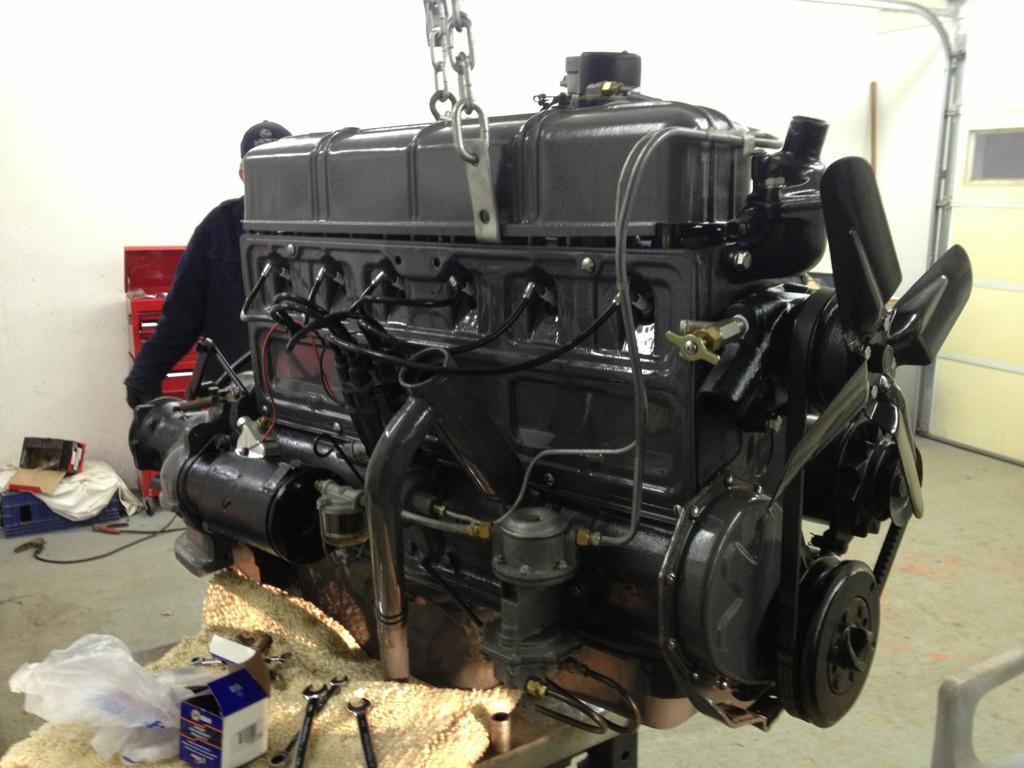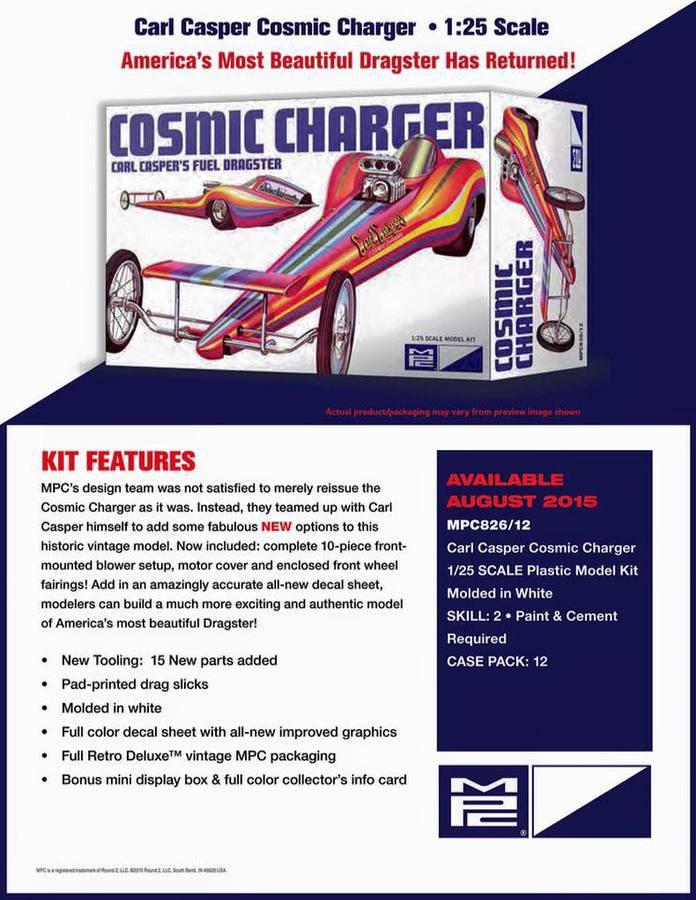-
Posts
4,561 -
Joined
-
Last visited
Content Type
Profiles
Forums
Events
Gallery
Everything posted by Force
-

Opel Blitz question
Force replied to Superpeterbilt's topic in General Automotive Talk (Trucks and Cars)
I respect your opinion Bill. I never claimed that the Opel 3.6 and Chevy 216 should be exactly the same engine as it's not, they are very similar as the pictures shows, but if you go into details you can of course find differences. The Opel 3.6 engine is obviously based on the Chevrolet 216 design as the article I provided says, but it's not an exact copy, the measurements are converted to the closest metric equivalent and it's developed and made by Opel to their own specs and for their own needs, it's not like they took raw engine block and head castings from Chevrolet and machined the internals to metric masurements, no the castings were made by different foundrys with their own molds half a World away so they are not 100% alike if you go into details. As I see it the differences between them are not like "apples and oranges", more like green appes and red apples...close outside apperance but tastes a bit different. -

Opel Blitz question
Force replied to Superpeterbilt's topic in General Automotive Talk (Trucks and Cars)
Here are a couple of pictures I found of the Opel 3.6 Litre engine. And a couple of pictures of the Chevy 216 cui I'm no expert on these engines but they looks to be quite similar to me. If an engine is based on another engine design doesn't mean they have to look exactly the same, they were built by two different manufacturers with their own foundrys and casting facilities on opposite sides of the Atlantic Ocean so of course there are differences here and there, but to me they look very close on the outside. -

Accurate, Modern US Trailer Kits?
Force replied to vincen47's topic in General Automotive Talk (Trucks and Cars)
Italeri haven't directly been known to make true kits all the time, they take shortcuts both here and there and try to pass off many things for what they are not, so the trailers are just one thing. -

A truckers view of mother nature.
Force replied to Petetrucker07's topic in General Automotive Talk (Trucks and Cars)
Very nice pics of beautiful views, Thanks!! -

Opel Blitz question
Force replied to Superpeterbilt's topic in General Automotive Talk (Trucks and Cars)
Well I did some research on the Opel 3.6 litre inline 6 subject a while ago and found this regarding the Admiral/Blitz engines from 1937 to 45, and that's what I grounded my earler statement on. Nothing fits between them as it's all metric but it's still based on the Chevrolet 216 according to this article. In 1936, and I assume here that the American deputy chief engineer at Opel Russell S. Begg was responsible, a new engine was designed for the forthcoming Opel Admiral model. The engine for this large Chevrolet-sized car was based on the new 1937-on 216 cu. in./3,549 c.c. 6-cylinder Chevrolet engine, with four main bearings. The Opel engine was copied from the Chevrolet by redrawing the original blueprint drawings and converting from Imperial to Metric measurements. In fact, at the end of the day the engine more closely corresponded with the Canadian Pontiac car engine for 1937, the 224 cu. in. unit, which was fitted into a Chevrolet-based bodyshell to create the Pontiac 224 model and also in Canadian GMC trucks. The “224” unit was created by increasing the Chevrolet 216.5 unit bore by 0.0625”, with aluminium pistons instead of cast iron. The Bore & Stroke were then 3.5625 x 3.75 in. [3 9/16 x 3 ¾ in.] [30.2 H.P. rated engine measured exactly at 224.1 cu in. The Opel engine became 90 x 95 m.m. Bore & Stroke, the nearest Metric equivalent, or 3.5433 x 3.74015 “, for 3,626 c.c. [Rated at 30.1 H.P., producing 86 b.h.p. @ 3,200 r.p.m.]. The Opel car engine had a 6:1 compression ratio as against the Chevrolet 6.25:1, and used the same transmission ratios as the Chevrolet: 2.94:1, 1.68:1 and 1.0:1.The smaller 2.5 and 2.6 Opel engines are a different story. -

Accurate, Modern US Trailer Kits?
Force replied to vincen47's topic in General Automotive Talk (Trucks and Cars)
Absolutely. Specifically, I was looking at my options of what to put behind my Prostar and VNL 780. The Moebius trailers will work (though it looks a tiny bit small behind the Volvo in the pictures I've seen, but it'll do), but I was taking inventory of what else is available. Thanks The difference is most likely a scale thing, the Italeri Volvo VN 780 is 1:24th scale and the Moebius trailers are 1:25th scale. -

Opel Blitz question
Force replied to Superpeterbilt's topic in General Automotive Talk (Trucks and Cars)
Opel is owned by GM and the 6 cylinder 3.6 litre engine in the older Blitz trucks and Admiral's were a metric version of the old Chevy Stovebolt 6. The later 6 cylinder in the later Blitz and Kapitän was an Opel developed 2.5 litre engine. -

1961 Buick Invicta Hardtop, Update 9/29, Engine Finished.
Force replied to StevenGuthmiller's topic in WIP: Model Cars
1961 is my favourite year for Buick's so I'm going to follow this. -
The Edsel Corsair and Citation are Mercury based and are quite far from the smaller Ford based Ranger and Pacer and I don't know if any 57-8-9 Mercury has been made as a model, so the Laurie Edsel are a bit hard to do..but if you want it enough it can most likely be done. The Milner 32 Ford has been made by Revell as an pre painted unassembled diecast kit, and MPC did a quite wrong plastic kit reissued by AMT a few years ago, MPC also did the Milner dragster from More American Graffiti, not a good one as with the 32 coupe but they did one anyway. The Falfa 55 Chevy was also made by Revell as a diecast kit and you can for sure convert the AMT 55 Sedan to resemble the movie car, or take a Revell 55 and graft on the roof from their 56 Del Ray to do a 2 door post. The Steve/Toad 58 Impala isn't that hard to do from either the AMT kit or the Revell kit. The Pharao's 51 Mercury, a 51 Mercury hasn't been done as a model kit and the 51 differs quite a bit from the available 49 Mercury's, the rear quarters are longer and the rear window opening is wider and has a different shape than the 49-50, the dash board are also different in the 50-51 so the 49 dash is wrong. The 56 Thunderbird driven by Susanne Sommers has been done by AMT as mentioned and Revell also did a pre painted diecast kit of the car. The Curt Henderson Citroën 2CV can most likely be done as Revell, Heller and Tamiya has done 2CV's, I don't know if they are the right year but there are not that much that differs. Holstein's 61 Galaxie Police car can maybe be done from the old AMT Styline kit
-
-
I saw this car at the Las Vegas race last fall.
- 154 replies
-
- wheelstander
- jolly rancher
-
(and 1 more)
Tagged with:
-

List of big rig truck engines in kits
Force replied to Bgrgbldr's topic in General Automotive Talk (Trucks and Cars)
Good to know, I haven't seen many celan old Iron Lung Cummins engines with any paint, the only clean engines I have seen were rebuilt and they were beige. But I will add this information to the list. -

cleaning glue off the windows
Force replied to jacoballardtattoo's topic in Model Building Questions and Answers
I use several glue types when I build models and each one for different purposes. I use Revell Contacta Professional cement type glue for most of the basic assemblys on the model, after 40 years of modeling and trial and error it's the best I have tried so far. I use thin brush type liquid cement for some things, especially when to mate two surfaces such as glueing the engine block halves together and similar things, I use cement glue first and put the halves together, when dried I brush the liquid glue on top of the joint and it will melt the plastic and loosen up the cement some and after it has dried completely and after sanding the joints are invisible without any use of putty. I use a couple different super glues thin and gel type and epoxi glue for details that aren't styrene plastic and for resin parts. I use white glue type kristal klear or similar for windows. And finally, I also use enamel clear coat to glue photo etched emblems and such on the body after it's painted. I never use super glue for windows as I don't want to take the risk of fogging the clear parts up wich the super glue does, so I use Kristal Klear and sometimes a little epoxi for extra strength here and there to glue them in. -

Concerning the NHRA TV lineup
Force replied to Nytrozilla's topic in General Automotive Talk (Trucks and Cars)
Yes he is, ever since Dave McLelland retired. Dave Rieff and Mike Dunn are on TV @Skip: NHRA didn't buy into anything, they let Force do modifications to the Mustang body mold he had so the new bodies would resemble the Camaro more, they changed the front, altered the sides and some more in the process, the roof stayed the same tho'...remember, he only had 2 months to do it and to do a completely new body from scratch takes a lot longer than that. I think he will have new Camaro bodies for next year....but they will most likely be a blob as all others and even the TMFC bodies are better. The problem here is that the bodies for FC and PS today are approved by NHRA and made according to their specifications...so there is where the changes have to be made. -

A Car Everyone Can Hate Equally
Force replied to Quick GMC's topic in General Automotive Talk (Trucks and Cars)
Ehh... Just because you CAN do it doesn't mean it's right. -
If you look at the clip, in the beginning there is a sign telling what car it is.
-
Nice work Roger, can't wait to see the finished model.
-

Concerning the NHRA TV lineup
Force replied to Nytrozilla's topic in General Automotive Talk (Trucks and Cars)
They have been running TBI's in NASCAR a couple of years now and that seems to work fine. Yes there are power to be made with EFI, but I think NHRA decided on TBI for two reasons, first, a TBI setup is most likely cheaper than a set of fully modified specially built Holley Dominators they use today (they also need two sets of carbs for each engine, one set when they dyno the engine and one set for the races where the dyno set doesn't work as well, with a TBI they just change the mapping), and the TBI's will fit on the manifolds they use now, second, I believe NHRA don't want the progress to get out of control and still want to have some control over it...good or bad...well...we'll see next year...remember computers are not allowed to control and regulate anything in drag racing, just for monitoring, and everything must be adjusted before the run...and I think they haven't changed that rule. If racers want to go more extreme there are classes for that, Pro Mod allows almost everything except Nitro. -
Yes a Hemi Barracuda or Dart couldn't go as SS/E as it has too much HP and too little weight, a heavier car with Hemi could fit in as Sox & Martin's later Superbird did, but not the A-bodied Barracuda's and Dart's. The AHRA Super Stock Eliminator class wich were for new or nearly new cars ran heads up began in 1968 but the class didn't have points until 1969, and the NHRA Pro Stock Category wich was pretty much the same came for the 1970 season. Sox & Martin's mechanic/engine builder Jake King painted all the engines he built Ford Engine Blue as a homage to his own time racing Ford's and to recognize his work.
-
1961 is my favourite year for Buick followed by '59, preferably Invicta/LeSabre, '65 and '71-'73 Rivieras.
-
Ouch!!! It for sure needs some work.
-

Concerning the NHRA TV lineup
Force replied to Nytrozilla's topic in General Automotive Talk (Trucks and Cars)
No they certainly don't, the so called Dodge Charger's DSR uses don't look like Charger's, the Toyota Camry's used by Kalitta Racing and the Pedregons don't look like Camry's either, and the Camaro's and Dart's in Pro Stock doesn't look like the cars they are supposed to be...NHRA has let it go too far. I don't even like the where the Nostalgia Funny Cars have evolved to, they are a lot better and you can for sure see what car they are supposed to be but in my opinion they have gone a bit too far with their low sides and even many of them have the undesirable wedge shape. If you don't like the corporate sponsorship and billboard cars we have today you have to blame Tom McEwen and Don Prudhomme for that as they were the first to do it, it's a professional sport and they need money to do it as it costs somewhere between 3 and 4 million Dollars per car per year to run a top level championship contending nitro car, Pro Stock isn't that far behind with at least 2 to 3 million Dollars per car to do a season. I don't know the answer but I think they maybe have to go back more to the roots to be more interesting, get more factory involvement, and for sure, the sport don't need any of the "fabricated phoney drama" the TV production companies often want's it to be...it's racing and it should be exciting enough without that. I'm involved in drag racing over here and the friendship in the pits is great and you can go to almost anyone and borrow parts if you need something, we are enemies at the starting line but when the race is over the hostilities are also over and most are great friends. I'm not that sure Live broadcasting is good for the sport either, oildowns and rain destroy the fun and you can do more good doing something else than look at the NHRA people drying or prepairing the track. it's no good for the economy for the racers eiter as they have to have more people on the payroll and more hardware to be able to meet the deadlines as the time between rounds are getting shorter and shorter wich Live broadcasting demands. But this type of racing needs TV for the sponsors as they want to be seen of as many as possible, if you don't have any TV coverage you can't get sponsors and the sport will...maybe not die but not far from it as you can't get any money from it, like it's over here in Europe, almost no TV coverage and finding sponsors that pay any money are almost impossible and the prize money for winning a race are rediculously low and doesn't cover the costs to race by far. -
I think there are some bugs in the system here and there, I uploaded a couple of pictures here and added them to a post yesterday and the appear every time I try to edit a post after that so I have to edit again and take them away every time, and if i delete them from the uploaded images box under the reply box they dissappear from the original post I added them to.
-
Sox & Martin ran many cars in different classes and sanctioning bodies back then. The Hemi Barracuda's and Dart's were classed SS/B or SS/BA first as the sanctioning bodies (most likely NHRA) thought something even hotter would come out from the factories and wanted to save the A weight break for them, later they were classed SS/A or SS/AA as nothing hotter came and these cars now have their own classification SS/AH. The "Super Stock Eliminator" class mentioned was a heads up 9 second AHRA class and has nothing to do with the NHRA SS/E weight break and was pretty much like the later NHRA Pro Stock class. I don't know when the blue headlight thing started, I have seen S & M cars with blue headlights as early as 1967 but it's not on all cars, maybe it was a way to recognize one car from another as they ran several similar cars at the same time.

